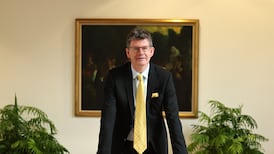An award-winning mathematician warns that the new maths has failed, and multiplication tables should be brought back, writes Dick Ahlstrom.
The new maths is a disaster and should be got rid of as soon as possible, according to a New Zealand mathematician. The decision to dumb down maths by shunning times tables in favour of a theoretical approach is making maths difficult to teach.
Professor of maths at the University of California, Berkeley Vaughan Jones speaks with some authority. In 1990 he won the prestigious Fields Medal for mathematics, an award that ranks with a Nobel Prize in terms of its international importance.
Jones was in Dublin last week to deliver an Academy Times Lecture jointly organised by The Irish Times and the Royal Irish Academy with the support of Depfa Bank plc.
It is one of a series of lectures taking place during 2005 to mark the bicentenary of the birth of William Rowan Hamilton, Ireland's greatest scientist. The Government has also designated this year as "Hamilton Year 2005: Celebrating Irish Science".
Jones delivered an entertaining talk on Hamilton and the complex mathematical concepts surrounding the Irishman's discoveries about non-commutative numbers. Appropriately Jones named his talk: Romancing the Commutator.
Students the world over are taught early on that A x B equals B x A. Hamilton turned that idea on its head with his discovery of quaternions, where the formula above is not true.
Jones pointed out however that non-commutative numbers have been with us from before Hamilton if we only looked for them. The formula a + b = b + a seems self-evident, he told his audience, but what if you throw in negative numbers. It is simple to prove for positive numbers but more of a challenge for negative numbers. "It is even less obvious for multiplication."
Reference to multiplication allowed him to exercise one of his pet annoyances, the decision taken years ago in many countries, including the US and much of Europe, to abandon rote maths tables in favour of the new maths. The result is that many students are incapable of doing the simplest algebra.
The approach has resulted in a dumbing down of maths "to an extraordinary extent", Jones believes. "It should be resisted at all costs," he says.
The US has replaced real maths with a kind of "self discovery" approach where students are led to a form of self learning of maths concepts. "But if you don't do this repetitive stuff it goes right out of your head," he says.
"The other thing you don't learn is any sense of the size of a number. How big is it? That is really hard with the new maths."
Even so it is remarkable that so much traditional maths, including counting, multiplication, division, addition and subtraction can be learned so quickly by four to seven-year-olds just into school. These simple functions represented the first few millennia of discovery in mathematics, up to about 500 years ago, he pointed out. "To me it is a miracle you can learn that so quickly."
Things get more complicated in more recent centuries however, probably from the time that mathematicians began to solve quadratic equations and later cubic equations. Jones highlighted the profound contribution of Rene Descartes.
Perhaps better known as a philosopher, Descartes was also a "very important mathematician" says Jones. "He turned geometry into algebra and made geometric shapes the same as equations." He provided us with the "X" and "Y" we use when creating graphs.
Jones brought his audience through the work done by 19th-century French mathematician Siméon Denis Poisson who devised the Poisson Bracket and applied it to classical mechanics. While his mathematics remained commutative, his bracket allowed a non-commutative structure.
Hamilton was able to use Poisson's work to devise "a version of Newtonian mechanics" that allowed non-commutative equations, says Jones. Hamilton then had his "flash of inspiration" while passing along the Royal Canal near Broome Bridge that delivered quaternions to a waiting world.
Jones travelled through the history of non-commutative mathematics in a relaxed way, interspersing the lot with personal observations on anything from All Blacks' rugby to another of his passions, windsurfing.
He also looked at the work of Alan Connes who wrote a book on non-commutative geometry, a concept that is little more than 15 to 20 years old. "That is very, very new for a branch of mathematics," Jones explains.
In effect, Connes brought things back to where they started with the link between algebra and geometry. If algebraic operators could be non-commutative, then could there be non-commutative geometry? Connes work allows this complex idea to exist and also opens up the possibility of a non-commutative universe.
Connes believes that a non-commutative universe can exist but only on an extremely small scale. He developed a model of Einstein's space-time configured in non-commutative geometry, and it suggests that given the right conditions and in small spaces, a + b will not equal b + a.








